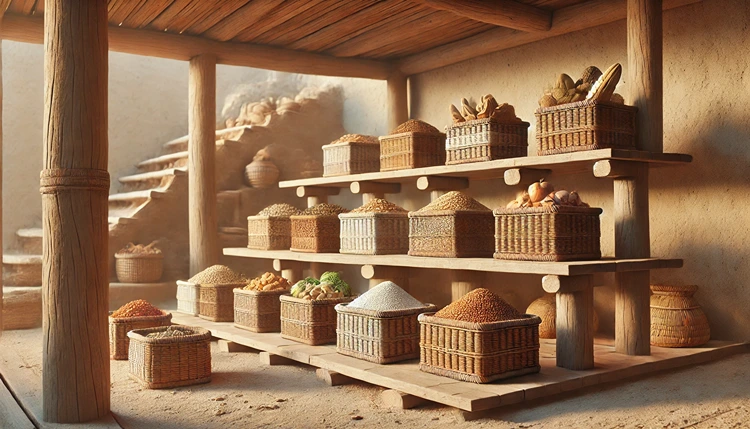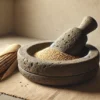The Aztecs were masters of resourcefulness, especially when it came to storing food. In a world without refrigerators, they had to rely on their deep understanding of nature and innovation to keep food fresh. How Aztecs preserved foods without refrigeration is not only a fascinating glimpse into history but also a lesson in sustainable practices. For a civilization that thrived in often challenging environments, their food preservation techniques were surprisingly advanced and effective. Let’s explore how they managed to keep their food fresh and edible for long periods, despite the absence of modern refrigeration.
Why Did the Aztecs Need to Preserve Food?
The Aztecs, living in a region that could be both fertile and unpredictable, needed to ensure they had food year-round. Harvests were seasonal, and certain foods would spoil quickly if not properly handled. Preserving food was essential not only for survival during droughts or harsh weather but also for sustaining large populations, particularly in cities like Tenochtitlan, which were home to thousands of people.
Helpful Hint:
The key to Aztec food preservation was understanding their environment. By using what nature offered—whether it was the sun, the dry climate, or abundant salt—they were able to create methods that kept food from spoiling without modern refrigeration.
What Techniques Did the Aztecs Use to Preserve Foods?
So how exactly did the Aztecs preserve food without the luxury of refrigerators? They relied on a variety of natural methods, which were highly effective in preventing spoilage and extending the shelf life of their ingredients.
1. Drying
Drying was one of the primary techniques used by the Aztecs to preserve a wide range of foods. By removing moisture from fruits, vegetables, and meats, they could prevent bacteria from growing and spoiling the food. Drying was especially common for corn (maize), which was a staple in their diet. The sun-dried corn could be stored for long periods and used in various dishes, including tortillas.
2. Smoking
Another method the Aztecs used was smoking, particularly for meats. After hunting, they would smoke meats like turkey and fish, which helped to preserve them for weeks, sometimes even months. The process involved hanging the meat over a fire, allowing the smoke to dry and flavor the meat at the same time.
3. Salting
Salt was a vital preservative for the Aztecs. They used it to cure fish, meat, and even some vegetables. By rubbing salt into the food, they could draw out moisture and create an inhospitable environment for bacteria. Salt-curing was especially important for preserving fish, as fishing was a major part of their diet.
Helpful Hint:
Salt, often harvested from lakes and salt pans, was a readily available resource for the Aztecs. Its use in food preservation allowed them to enjoy fish and meats long after they had been caught or hunted.
4. Fermentation
Fermentation is another ancient technique that the Aztecs practiced to preserve certain foods. By allowing natural bacteria to break down sugars in food, they could create longer-lasting staples like pulque, a fermented beverage made from the sap of the maguey plant. Fermented foods and drinks not only lasted longer but also provided additional nutritional benefits.
Aztec Food Preservation Methods and Their Benefits
| Method | Food Type | Benefit |
|---|---|---|
| Drying | Corn, beans, fruits, vegetables | Removes moisture, preventing bacterial growth and allowing long-term storage. |
| Smoking | Meat, fish | Preserves and adds flavor, while also extending shelf life. |
| Salting | Fish, meat | Draws moisture out of food, making it inhospitable for bacteria. |
| Fermentation | Drinks (pulque), maize, plants | Enhances nutritional value and prevents spoilage for extended periods. |
| Underground Storage | Vegetables, grains | Maintains a cooler temperature, preventing spoilage due to heat. |
| Herbal Use | All foods | Natural antimicrobials help prevent bacterial growth and preserve food. |
How Did the Climate Help the Aztecs Preserve Foods?
The warm and dry climate of the Aztec region was a crucial factor in their ability to preserve food. The sun was their most reliable ally in drying fruits, vegetables, and meats. High temperatures and low humidity levels were ideal for preventing the growth of bacteria and fungi that would otherwise spoil food.
For example, dried chilies were a major part of the Aztec diet, and these could be easily dried in the sun and stored for long periods. Likewise, the hot sun helped speed up the process of drying corn and other grains, ensuring that food supplies remained stable even during less productive harvest seasons.
Did the Aztecs Use Special Storage Techniques?
The Aztecs didn’t just rely on preservation methods—they also developed clever ways to store their food. Granaries and underground storage pits helped keep food cool and protected from pests. In some areas, they built raised storage platforms to keep food off the ground and away from moisture.
These simple but effective storage techniques allowed the Aztecs to stockpile food for months at a time, ensuring they had enough to feed their families and communities during leaner periods.
“The Aztecs showed us that with knowledge of the environment and a bit of ingenuity, you can preserve food without the need for modern technology.”
How Did the Aztecs Preserve Drinks?
Not only did the Aztecs focus on preserving solid foods, but they also found ways to make their drinks last. Pulque, their fermented drink, could last for weeks due to the fermentation process. Additionally, water sources were often guarded and kept clean to ensure they always had access to fresh drinking water.
Freshwater lakes and rivers were key to their survival, and they understood the importance of protecting these resources. They also had aqueduct systems to transport fresh water to cities, ensuring a reliable supply even during dry periods.
How Did the Aztecs Preserve Vegetables and Grains?
Vegetables and grains were just as crucial to the Aztec diet as meats and fish, and preserving them required a different set of techniques. Corn, beans, and squash were some of the most important crops, and the Aztecs had unique ways of ensuring they could store and use these staples for long periods.
1. Drying Corn and Other Grains
As mentioned earlier, corn was a dietary staple for the Aztecs, but it didn’t stay fresh forever in its natural state. To preserve corn, they would dry the kernels in the sun after harvesting. This process helped reduce the moisture content, making it easier to store and preventing spoilage.
Once dried, the corn could be ground into flour for tortillas or stored in large granaries, which kept the kernels dry and free from pests. This method ensured that corn was available year-round, even during the rainy seasons when fresh harvesting wasn’t possible.
2. Storing Beans
Beans were another essential crop for the Aztecs, providing a rich source of protein. The drying process was also used for beans, as they could be left in the sun until they hardened, allowing for extended storage. Once dried, beans could be kept in ceramic jars or woven baskets, which protected them from moisture and pests. This allowed the Aztecs to store large quantities of beans for months, ensuring they always had access to a protein-rich food source.
3. Squash and Other Vegetables
Preserving vegetables like squash required different techniques. In some cases, the Aztecs would slice and dry vegetables, just like they did with corn and beans. This method worked particularly well for varieties of squash, which could be cut into thin strips and dried in the sun.
Additionally, they often stored vegetables in cool, shaded areas or underground pits, where they would remain fresh for longer. The combination of drying and careful storage made it possible to keep a variety of vegetables available throughout the year, ensuring a balanced diet even during off-seasons.
Helpful Hint:
Want to try drying your own veggies at home? Slice them thin, lay them out in a single layer under direct sunlight (or in a dehydrator), and let the natural drying process take over. It’s a simple and effective method used by the Aztecs that still works today!
How Did the Aztecs Prevent Spoilage?
In addition to their food preservation techniques, the Aztecs had a strong understanding of how to prevent spoilage. This knowledge came from years of observation and experience. By identifying foods that spoiled quickly and finding ways to protect them, they could avoid the dangerous consequences of eating contaminated food.
1. The Role of Herbs and Plants
Herbs played a big role in preventing food from spoiling. Some herbs have natural antimicrobial properties that help keep bacteria and fungi at bay. The Aztecs used herbs like oregano and epazote to preserve food, as these plants were known to inhibit the growth of harmful microorganisms.
2. Keeping Pests Away
Pests were a major threat to stored food. Insects and rodents could easily ruin food supplies if they gained access to storage areas. To prevent this, the Aztecs used natural deterrents like ashes or sand around their storage pits, making it difficult for pests to infiltrate. They also built storage structures that were elevated off the ground to protect food from animals.
3. Rotating Food Supplies
The Aztecs were careful to use their older food supplies first, ensuring that nothing went to waste. By rotating their food stores and using the oldest items first, they reduced the risk of spoilage and ensured they always had fresh food on hand. This practice, combined with their natural preservation methods, allowed them to avoid food shortages and waste.
What Foods Were the Most Commonly Preserved?
The Aztec diet was diverse, but there were certain foods that were commonly preserved using the methods discussed above. These foods were not only staples of their diet but also important for trade and survival.
- Corn: As the cornerstone of the Aztec diet, dried corn was stored in large quantities and used to make tortillas, tamales, and other dishes.
- Beans: High in protein and easy to dry, beans were a reliable food source that could be stored for long periods.
- Chilies: Dried chilies added flavor to many Aztec dishes and could be stored for months without spoiling.
- Squash: Dried strips of squash were stored for use in soups and stews.
- Fish and Meat: Smoked and salted meats and fish were essential for keeping protein in the diet during times when fresh food wasn’t available.
Can We Use These Techniques Today?
While we have the convenience of refrigeration and freezers today, many of the techniques used by the Aztecs are still relevant. Drying, salting, smoking, and fermenting are all methods that can be easily practiced at home, and they offer a more sustainable way to preserve food. Whether you want to try your hand at making dried vegetables or experiment with smoking your own meat, these ancient methods offer a practical and eco-friendly alternative to modern preservation techniques.
Why Should We Look to the Past?
Looking back at how the Aztecs preserved food without refrigeration reminds us that sustainability and resourcefulness are not new concepts. In fact, these ancient practices may hold the key to reducing our reliance on modern technology and minimizing food waste. By adopting some of these methods, we can better connect with the earth, reduce our environmental impact, and preserve food in ways that are both practical and respectful of nature.
FAQs
Wrapping Up
The Aztecs demonstrated remarkable ingenuity in their food preservation techniques, showing us that even in the absence of modern conveniences like refrigeration, it’s possible to keep food fresh and safe. By leveraging their environment and developing methods such as drying, smoking, salting, and fermentation, they ensured food security for their communities. How Aztecs preserved foods without refrigeration not only offers a glimpse into their advanced understanding of food preservation but also highlights timeless practices that can inspire modern sustainability. These ancient methods remind us of the importance of resourcefulness and the power of nature when it comes to food preservation. As we continue to explore and adopt sustainable practices, the Aztec approach remains a valuable lesson in how to live in harmony with the natural world. Whether you’re looking to reduce food waste or experiment with these time-honored techniques, the wisdom of the Aztecs provides a fascinating blueprint for preserving food with minimal impact on the environment.








